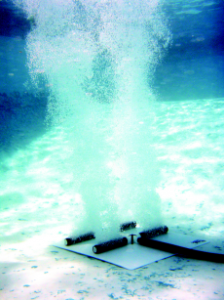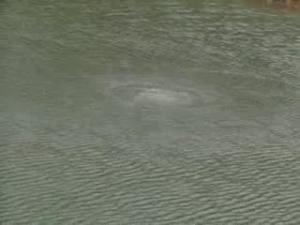 Aeration systems come in different shapes, sizes, types and forms from a small 1000 gallon pond to 6 acres and larger lakes. In this case cheaper isn’t always better. Fact is you can hurt your pond even more by under sizing the aeration system.
Aeration systems come in different shapes, sizes, types and forms from a small 1000 gallon pond to 6 acres and larger lakes. In this case cheaper isn’t always better. Fact is you can hurt your pond even more by under sizing the aeration system.
Before you buy the aeration system for your pond make sure you know what you’re getting into…
Yes there are plenty of units out there that give you a description like “for up to one acre pond” true it maybe sized for an acre pond but there are more details that come into play. The most important is the depth of the pond, then the overall size and shape of the pond and what type of water comes into the pond from the watershed. Is the watershed coming from farm land, wooded area, road ways, and streams? All of these are a source of nutrients coming into the pond from fertilizer, pet waste, grazing animals, water fowl and birds all have an input to the watershed that reaches our pond.
Aeration mistakes happen when we are not sure what size or type we really need in the pond. Under sizing the aerator can actually help grow algae and weeds. Algae only needs 2 mg per liter of dissolved oxygen to grow, fish need double that and even at 4 mg per liter the fish are stressed worrying about breathing when they should be eating. They can survive but keeps them from growing bigger. The goal is at least 5 mg per liter of dissolved oxygen in the water from top to bottom of the pond. Getting Oxygen to the bottom of the pond will help clean up the bottom muck. For additional muck reduction, add beneficial bacteria to control odors, murky water and excess nutrients.
There are two types of compressor’s for aeration, there’s the diaphragm and the piston type, both oil less so no oily  film contaminates the water. The diaphragm air pump is for shallow ponds and depending on the model good for up to 6’- 8’ feet deep.
film contaminates the water. The diaphragm air pump is for shallow ponds and depending on the model good for up to 6’- 8’ feet deep.
The second type of compressor is a piston type to create more pressure in order to reach depths up to 30’. Remember swimming to the bottom of a swimming pool or pond? The pressure on your ears is the reason more pressure is required to push air down to the diffuser at deeper depths. Along with the air pressure of the piston compressor is an ample volume of air flowing to the diffuser. At 24’-30’ of depth the Airmax diffuser circulates 4,357 gallons per minute.
The bad part of under sizing the aeration system is down the road a little you’ll see the algae, duck weed coming back, and in time back to the same situation and reason you bought the aerator. The aerator maybe doing its job but is undersized, either for the size and volume of the pond or the wrong compressor for the depth of pond. Even the wrong diffusers or mismatched components could leave areas with lack of oxygen. Not being able to provide enough oxygen and enough water movement to do the job right, the nutrients will overtake the aeration system. Phosphates and Nitrates are not bound by the oxygen and become a food source for the algae and weeds once again. When you are ready to add aeration to your pond or lake please click the Contact button on the top of the site and we will calculate an aeration system that fits and is properly sized for your pond. The deeper the water the more water is affected and moved by the air bubbles. In the video below you’ll see the piston type turn on and the water movement. Check out the video below and stop by the Pond Aeration product page for more info and the different systems.

I have a 3 year old pond 100’x100′ and 8′ deep. There are some Bluegill and Tilapia fish in it. The water remains cloudy, and the mud of the bank has become blackish and somewhat smelly. Sometimes a brownish scum collects on the surface. The surrounding area is covered with grass. What kind of reliable aerator pump system kit I should buy? Some say Linear compressor pump, others say Diaphragm compressor pump, and so on. I like something reliable, durable and not very costly to run. I am a retired individual. Can anyone help?
A.S.Alam
I tried to submit a ticket but it would not link to anything. I would be interested in what you would suggets in the way of aeration for my pond. What info do you need?
BNS
Hi,
I have a pond approximately 80ft in diameter. It’s a circular pond with a depth of 15 ft in the middle. The pond has a zip line over the top and is frequently used for swimming but is a greenish color and produces algae over time. I would like to make the pond a little more clear. The natural wildlife is frogs and some fish. It’s fed from a natural spring from below. The pond was dug this way. Any additional info I can provide? Thank you for your time.
Rob neale
Brush prairie wa
HI Rob, Please send us an email, the address is in the top right of the website.
We try to use all natural product in the pond for water clarity and quality and try to avoid using chemicals/herbicides unless absolutely needed. We use three different items. All products are safe for humans, pets, and wildlife.
Bottom diffused aeration: Creates water movement, adds oxygen to the bottom of the pond for aerobic bacteria’s to consume muck on the bottom and suspended organics in the water column. Operation would be from May through September sometime October depending on the weather. Power consumption is approx $11 per month running 24/7 For the depth of your pond you would be looking at a deep water system. From either of the top two Pond Aeration companies
Beneficial Pond Bacteria: Although these bacteria are in and around the pond there are not enough to keep up with the task of cleaning the pond so we add on a bi-weekly treatment to keep the bacteria colonies alive and thriving. Generally starting in May through the end of September when the water temp is up and the pond is not flowing through too fast. These bacteria will consume the muck and suspended organics in the pond but will not consume inorganic such as clay. It is a slow process but leaving it alone to nature the pond would fill in over time. This would be a yearly process since the pond flushes out during winter and we have new nutrients loading the pond each year, from fish, geese and the rain coming to the pond.
Pond Dye: mostly used to color the pond to a natural blue color. Does add some protection to the fish and bacteria. On a side note the color of blue varies depending on the water quality and clarity. If there are a lot of suspended organics the blue can be lighter in color. If the water is relatively clear then we would see darker blue. If the pond does not flow through too much we should see the color stay in the pond for the season. It usually washes out of the pond during winter or major rain storm.
These three items will help to improve water clarity and water quality along with removing muck and suspended organics.
Please send us and email and we’ll work out the best pricing for you, as a package deal and to be sure you get the right size and type of products.
I’ve converted my in ground 20′ x 40′ x 9 ‘ (max) free form swimming pool into a pond. Pond surface is 40 – 60 % plant covered on floating islands. I have mosquitoefish, goldfish, koi, bluegill, and catfish. Fish and plants both growing well but I think aeration would be good to keep my deep end circulating, as I not running a pump or filter system. What size do I need?
HI Sandy, Great question and sounds like very nice looking pond. There really is only one type of aeration system for the pond being 9′ deep and that would be a piston type compressor due to the depth the bottom diffuser would be at. The reason we couldn’t use a linear diaphragm compressor is the depth. If you recall when swimming in the pool and swimming to the deep end your ears would pop? That is the water pressure the compressor has to over come to push air down and out the diffuser. For deep water compressor I have two different models One is the PS10 and the other is the PA34D The reason I ask about location is if you do freeze over or have cold winter we may want to leave the 9′ deep area alone for a warmer spot for the fish.
Do you live in the upper states where you freeze over on the pond / pool? If so and you have a shallow end no more than 7′ deep then we could go with a linear diaphragm compressor system. There is a fine line for these compressors, even the differences in brands makes a difference in the depth. I’ve tried 9′ deep and the compressor only lasted about six months. So 7′ is the max and I would be looking at the PA6SW system if you had 7′ in about the middle of the pond area.
What is your opinion of the rotary vane type pumps. Going to have a 4 – 5 acre by 12′ – 15′ pond built. One of the aeration systems I am looking at uses a rotary vane pump. Not sure of the advantages/disadvantages verses piston or other type air pumps. I won’t be using a diaphragm type.
Good question. I have not used a rotary vane pump but looking at the spec’s they do limit depth of 18′ on the larger compressor’s and a 1/4 hp rotary is limited at 10psi. The rocking piston compressor have no problem reaching 50 foot of depth. And yes the linear diaphragm compressors would not work at all in your pond depths and fining they are really only good to 6′ of depth. Even though they some manufacturer’s say 7-8′ deep it would all depend on how often you want to rebuild the compressor.
EasyPro has a rocking piton system which would cover up to 4 acres, https://www.whatpond.com/pa86-aeration-system/ They also have the rotary vane systems, which I can get, just don’t have them listed on my site.
Airmax also has rocking piston systems Pond System 40 which has 4 diffusers, https://www.whatpond.com/ps40/ and a Lake System up to 6 diffusers, https://www.whatpond.com/pond-products/pond-aeration/large-lake-aerators/ The other difference of rotary versus piston is the rotary is more of a whine while the piston would be more of a hum. Airmax does have a decibel chart which I’ll have to try and find and get on the site.
If your pond is round or square you should be able to only use 4 diffusers if you get more on the oval, long and narrow in shape, increasing the diffuser maybe needed.
Hope this helps and if you have any other questions feel free to ask or if you need hep is calculating or design send us an email and we’ll get it done.
One last thing about the various compressors. The closer you push the max depth the more the compressor works, using more electricity and more wear and tear on the unit. Example of a linear diaphragm compressor says it has the ability to reach 12′ but you will not get the full amount of air only a fraction of the air. And most likely would need rebuilt in a couple months. I proved this at 9′ foot of depth. So my opinion is the rocking piston compressor the best way to go.